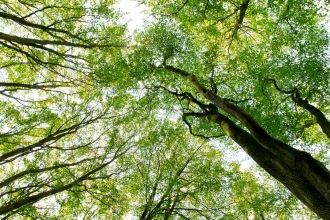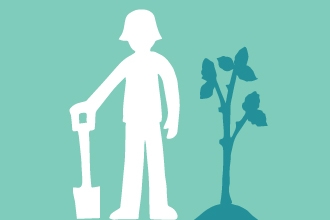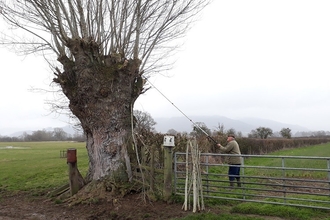‘The right trees, in the right places…’ A guide to natural regeneration, tree planting and aftercare
Trees and Climate Change
A surge in public awareness and demand for action on climate change pushed the UK Government to declare a state of ‘Climate and Ecological Emergency’ in 2019. In Herefordshire, the Council have since made a commitment to achieve carbon neutrality by 2030. Trees are highly efficient at storing carbon, so planting trees and increasing woodland cover is one of the best ways in which we can mitigate the impacts of climate change locally. Herefordshire has between 10-20% tree cover, and HWT believe that by 2030 this should be increased by at least 50%.
In addition to storing carbon, trees can reduce air pollution, mitigate flooding, and aid soil retention. They are also fantastic for our wildlife, providing a home for many different species and creating essential corridors to allow wildlife to move through our countryside. Climate change poses a huge threat to our native wildlife but creating a mix of wooded and open habitats within Herefordshire can help to rebuild our wildlife networks.
Whilst understanding the drive to plant new trees, HWT believe that increasing our tree cover should also be achieved by protecting existing young trees and through ‘new ‘natural regeneration’. Protecting trees which are already present is just as important as planting new trees.
Natural Regeneration
Natural regeneration occurs when trees grow from seeds that have fallen from a nearby woodland. It is natural, cheap, low carbon and low resource, as there is little need for canes, guards, and time-consuming aftercare. Trees that grow from natural regeneration tend to be better adapted to the local environment and have a better chance of survival. Natural regeneration also encourages genetic diversity, allowing our woodlands to build resilience to disease and natural adaptation to a changing climate.
Natural regeneration takes longer to establish than planting, but the bramble and scrub stages during woodland succession bring additional benefits for wildlife. This type of re-wilding doesn’t need to be large scale to have a positive impact, it can just be small corners and strips of land extending or linking other habitats. Good areas to regenerate include:
- In woodlands - Natural regeneration is successful here due to the abundance of tree seed. You can combine this with planting new trees to diversify the woodland where appropriate.
- On ryegrass pasture, arable land, and amenity land– choose land close to a natural seed source, e.g. an existing woodland. If left unmanaged, this land will revert to tussock grasses, scrub and eventually woodland.
- In hedgerows - identify healthy saplings in the hedgerow which can grow into mature trees and tag these to prevent them from being cut when the hedge is flailed. Damaged and heavily managed hedgerows can be restored through less flailing, protection from stock grazing, and gapping up with new hedgerow trees. This allows them to expand in height and width to provide better structure, shelter, and food for wildlife.
Tree Planting
Tree planting should be in accordance with Forestry Commission guidance and can be funded through existing schemes or grants. It is important to check that the stock you are using is grown from locally sourced seed (ideally Herefordshire but as a minimum England or Wales). HWT recommend that native tree species are sourced from the appropriate Forestry Commissions Seed Zones. COVID-19 precautions must also be taken if you are planting trees with a group of people.
All trees store carbon, so it is important to consider how the tree species you plant will benefit wildlife as well as mitigating climate change. HWT recommend a variety of native broadleaved species of differing ages, which are best for wildlife and still store carbon. Over half of the carbon sequestered by trees is stored in the soil, so avoid disturbance to soil where possible. Trees with longer lifespans capture more carbon but ensure that you are not prioritising carbon storage over a healthy ecosystem. Planting of conifers is not recommended as the dark canopies absorb sunlight which contributes to our warming climate and cancels out any positive impact.
Where to Plant
Many of our habitats in Herefordshire already store fantastic amounts of carbon, so make sure that you are planting the right tree in the right place to avoid damaging good wildlife sites or reducing carbon stored in the soil. The main principles for improving sites for wildlife are better management, bigger sites, more sites, and improved connections between sites (Lawton, 2010). So, make sure that your tree planting locations meet these principles to help wildlife spread naturally through the landscape. Ideally take expert advice before you plant any trees, but good places to choose include:
- In woodlands - plant on the fringes to extend existing woodlands.
- On ryegrass pasture or arable land – land that has been continually ploughed is the best as it will have lower carbon content. Creating small areas of woodland in field margins can provide habitat for wildlife, as well as capturing carbon.
- In traditional orchards – plant locally sourced fruit trees here to fill gaps and extend the life of the orchard. Planting a variety of trees helps to maintain genetic diversity which may be important in adapting to climate change.
- Along river corridors – planting bankside trees here will benefit the environment by providing shade to keep the river temperature cool, reducing soil erosion and supporting a range of riverside wildlife such as fish and invertebrates.
- In parkland – trees in the open grow more rapidly, with wider crowns and more leaves, increasing their ability to capture carbon. Parklands usually host most of our ancient veteran trees, but it is beneficial to plant new trees here to succeed the veterans and ensure continuity of the habitat.
- In gardens – collectively gardens occupy 30% of the urban area in England, providing a great opportunity to increase tree cover. Small fruit or berry bearing trees are best.
- In towns and cities – planting trees here encourages people to connect with nature and take part in community action for climate change, as well as providing shade and reducing air pollution.
- In places where old hedgerows have been lost – plant new hedgerow trees here to reconnect existing hedgerows and woodlands. Make them as wide as possible to provide food and shelter for wildlife.
Where not to Plant
It is critical that you do not plant trees on sites which are valuable for other wildlife, or in natural habitats which already effectively store carbon. Places not to plant trees include:
- Local nature reserves, local wildlife sites, national nature reserves or Sites of Special Scientific Interest.
- Habitats which are important for wildlife (including land which has potential to be restored to these habitats) – avoid wildflower rich grasslands, commons, peatland, fens, expanses of wet meadow, scrubby bracken, wetlands and any grassland areas which have not been ploughed in the last 10 years. These already store lots of carbon and support a range of important wildlife.
- Historic parks, gardens, or places of archaeological importance.
Aftercare of Trees
Studies have shown that well managed woodlands capture more carbon and support more wildlife than unmanaged woodlands. The after-use of trees is also an important consideration. High grade timber used for construction and sustainable products will allow carbon storage long after felling and contributes to our reduction in plastic and other unsustainable products. Aftercare of trees is important for their success and longevity, and may include:
- Squirrel control to prevent damage or death of developing trees from bark stripping. Grey squirrel are not native and cause extensive woodland damage.
- Deer control via fencing, culling, and use of tree protector tubes. We have six species of deer in the UK of which only two are native, and numbers are at a record high.
- Thinning of trees (both planted and naturally established) to ensure we create healthy trees that can have a long life and serve a range of sustainable end-uses.
- Watering, especially in hot, dry summers.
- Removal of competition from grass and other plants. Newly planted trees establish more successfully if the area around the root plate is free of competition.
Further Information & Useful Links
Herefordshire Wildlife Trust: The Right Trees in the Right Places: a guide to natural regeneration, tree planting and aftercare. https://www.herefordshirewt.org/sites/default/files/2020-10/Tree%20guidance.pdf
Forestry Commission Tree Species and Provenance Guidance https://www.forestresearch.gov.uk/tools-and-resources/tree-species-and-provenance/
Best practice for socially distanced tree planting events file:///C:/Users/e.baggett/Documents/Ecological%20Support%20Officer/Tree%20Planting%20Scheme/Best-practice-for-socially-distanced-tree-planting-events.pdf
Woodland Carbon Guarantee tree planting scheme https://www.gov.uk/guidance/woodland-carbon-guarantee
Forestry Commission Priority open habitats and woodland creation. A field guide (2020) https://www.herefordshirewt.org/sites/default/files/2020-12/Priority%20open%20habitats%20and%20woodland%20creation.pdf
Grassland botanists in Herefordshire https://www.herefordshirewt.org/sites/default/files/2020-12/Grassland%20Botanists%20in%20Herefordshire.pdf



